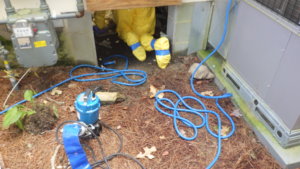Standing Water in Crawl Space
Have you found standing water in your crawl space? This is actually very common and you might be one of the hundreds of other homeowners asking themselves what to do next.
If you are, take a deep breath and read our short guide on how to deal with standing water in your crawl space. We will explain to you why you should not leave water standing, what can cause this problem and how to get rid of it once and for all.
Is Standing Water in Crawl Space Normal?
Some homeowners panic looking for any signs of water and moisture in their crawl spaces. Some do not even know it might be an issue. So is standing water in crawl space really a problem?
The simple answer is yes, it is.
It might be okay for some water to accumulate under your house after heavy rain. But all water should have an effective way out of your home and should never turn into a “standing” water.
Standing water can cause wood to rot and mold growth. Mold in crawl space is a serious issue: it damages the house foundation and affects the air quality in the entire home. Other adverse effects of humidity in the crawl space are high electric bills and common crawl space pests like mice, rats, and termites.
What Causes Standing Water in Crawlspace?
The first step to dealing with standing water in crawl space is determining its source. Some of the common causes of flooded crawl spaces are:
- Cracks in the Foundations. Rainwater and groundwater may seep into our crawlspace through cracks or leaks in the foundation of the house. Inexpensive block foundations and stone foundations are especially prone to cracking and letting water and air in.
- Drainage issues. Drainage issues occur when water enters the crawl space and the drains, gutters or downspouts are damaged or improperly installed. Another important factor is grading on the landscape: a slope towards a foundation vent is sure to cause water problems in your crawl space.
- Rising groundwater. A sump pump can be used to keep the rising groundwater away from your crawlspace. If you don’t have one or it’s improperly installed, groundwater may accumulate causing further damage.
- Plumbing issues. Crawl spaces flooding may be caused by burst or leaking pipes clogged sewage lines and overwhelmed sewage systems. Since the access to crawlspaces is limited, water may be left standing for a longer period of time.

What are the Solutions?
To get rid of the standing water in your crawl space, you should effectively determine and address its causes. If you are not sure about what makes your crawl space flooded, call in professional water restoration experts to inspect your home. Random DIY tips that do not address the cause of standing water might just waste your time and effort. Standard solutions to water in crawl space include:
Adding proper grading
Check your property grade and low point drain. Do not allow a poor sloping grade to direct water to your home structure, you simply need to build it up. The slope should extend for at least the first 6-8 feet from the foundation walls. Mind that rain and snowmelt can wash away the slope, so it’s better to check the grade from time to time and take measures if needed.
Correcting a low point drain issues
To allow water to escape the crawl space, a low point drain should be installed at the lowest point of the crawl space and slope towards the street. It happens that a crawl space has a flooded section that does not connect to the drain. You may solve the problem trenching a line between the section and a low point drain or a sump pump. If the standing water in your crawl space is below this drain, it was installed above the lowest point thus, it will not perform its intended function. If the water covers the drain but does not flow out, the drain is likely clogged. In this case, it’s better to stick to a sump pump.
Installing sump pumps
A sump pump is a great resource to get standing water out of your crawlspace. A sump pump should be installed in a basin dug in the lowest point of the crawl space. If you are installing the sump pump on your own, be sure to use a backflow valve on the discharge pipe and install a GFCI outlet to prevent electrocution.
Installing, repairing or cleaning gutters and downspouts
Gutters and downspouts should direct rainwater away from your home. Downspouts should point away from the foundation wall and have a splash block guiding water away. Make sure the splash blocks are not less than 2 feet long. Extensions at the base of the downspouts are also a good solution to move water further from your home.
Waterproofing and encapsulation
Waterproofing and encapsulation will help to keep water and moisture off your crawl space. The processes involve shielding a crawl space floor and foundation walls with a vapor barrier. To increase the effectiveness of the solution, professionals install a dehumidifier that controls a crawl space moisture level.
If you discover water in your crawl space, don’t turn a blind eye on the problem. If the cause of the flooding is not obvious, schedule a free inspection with a local restoration company. A professional inspection will give you clarity about the drainage system of your property. Experts will also reveal any pipe leaks or pipes that are about to fail to which can prevent any major plumbing issues.





